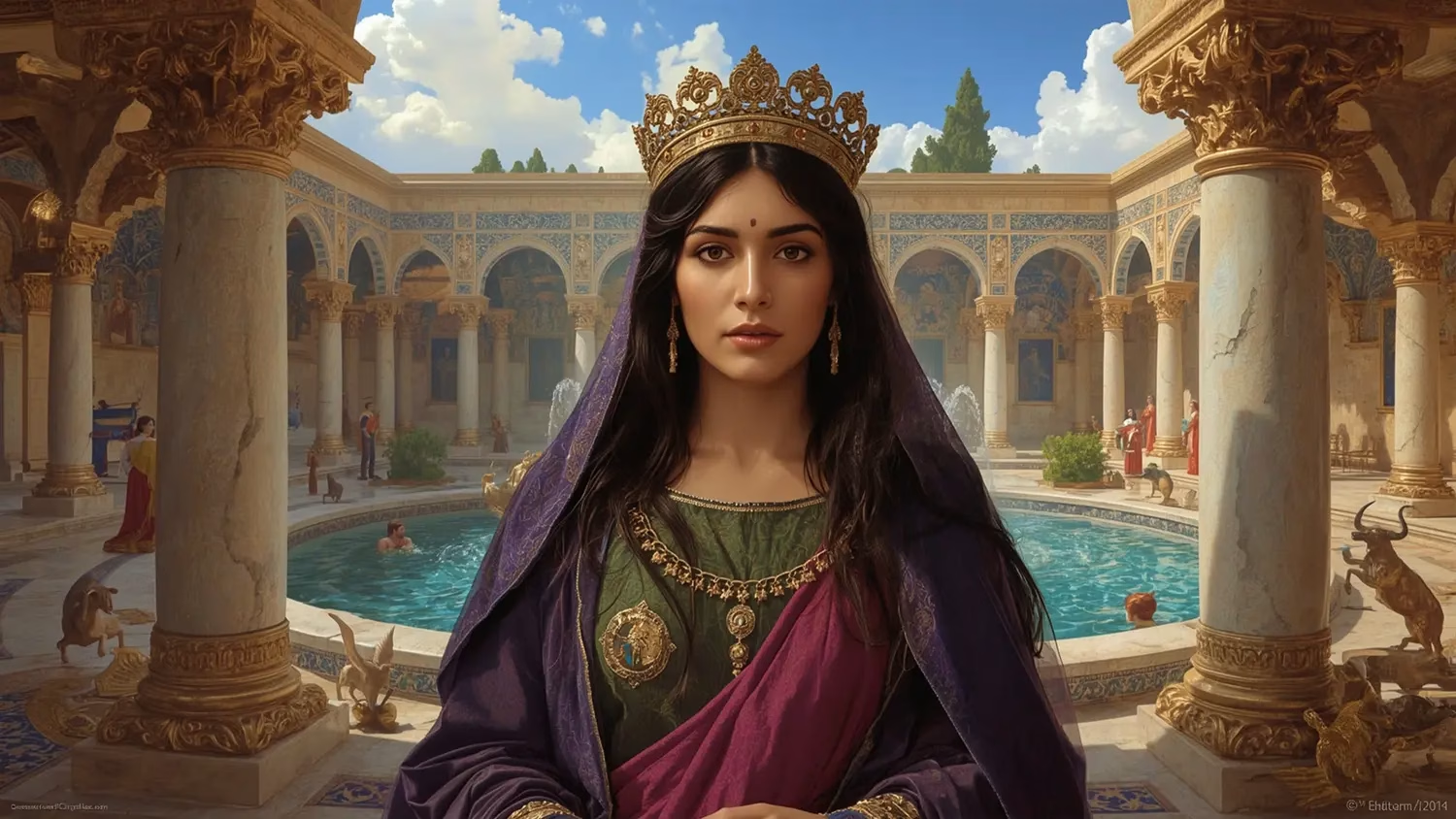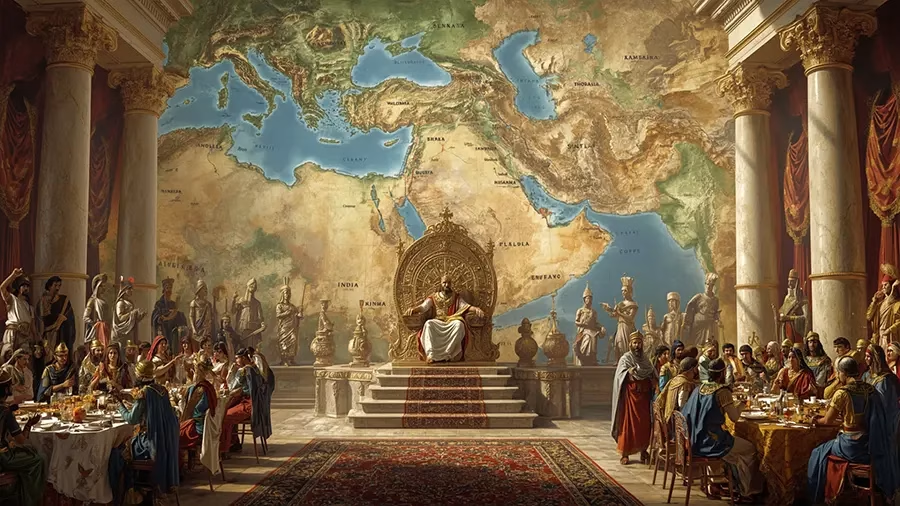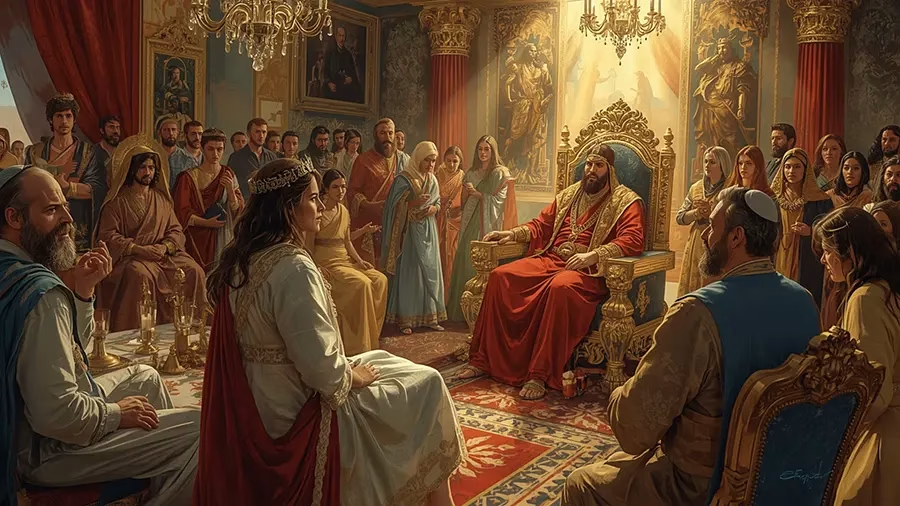
The Book of Esther 1 is one of the most fascinating narratives in the Bible, blending history, politics, and divine providence. Celebrated globally during the Jewish holiday of Purim, Book of Esther 1 introduces us to Esther’s story that spans over 2,600 years back to 483 BC, in the vast Persian Empire. This article explores the fascinating context of King Ahazerus’ reign and the extraordinary rise of Esther, a Jewish orphan, to the throne of Persia. Her courage and wisdom have eternal significance for believers and historians alike.
Table of Contents
Purim, marked every year around March, owes its existence to Esther’s bravery and intervention to save the Jewish people. Also known as Hadasa to many Jews, Esther’s story is confirmed by historians and archaeological findings and remains a timeless lesson about faith, power, and destiny.
Read more in our Bible Messages.
Understanding the Persian Empire Context in Book of Esther 1
The Reign of King Ahazerus
King Ahazerus, the central figure introduced in Book of Esther 1, was the ruler of an empire that spanned 127 provinces – from India to Ethiopia. This empire may be one of the largest in recorded human history. Key territories under his control included modern-day Egypt, Bulgaria, Romania, Cyprus, Ethiopia, Kuwait, Iran, Georgia, Azerbaijan, India, Kazakhstan, Pakistan, Turkey, Syria, Iraq, Lebanon, Israel, and Jordan. Imagine the logistical and political challenges of reigning over such a vast multicultural empire!

Historical Context Behind Ahazerus’ Six-Month Feast
Book of Esther 1 records that early in King Ahazerus’ reign, in his third year, he threw an extraordinary 180-day (six months) feast for his officials, nobles, and provincial rulers, followed by a seven-day state feast. This lavish celebration had a strategic purpose. Ancient historian Herodotus explains that Ahazerus planned to consolidate power and resources for an ambitious military campaign to conquer Greece. By hosting provincial leaders in manageable groups, Ahazerus was able to impress them lavishly, collect vital military contributions (men, ships, weaponry), and build unity among the often disparate and warring ethnic groups under his rule.
Significance of the Palace at Shushon (Susa)
The palace where these feasts took place, located in Shushon (modern-day Susa), was a monumental architectural wonder, known from archaeological excavations and Persian art. The grandeur of the palace, with marble pillars, mosaic pavements, gold and silver furnishings, and royal wine served in uniquely crafted goblets, symbolized the immense wealth and power of the empire. These surroundings set the scene for the drama about to unfold in Esther, demonstrating the contrast between earthly splendor and human frailty.
Queen Vashti’s Defiance: A Pivotal Moment in Book of Esther 1
Queen Vashti’s Bold Refusal
Book of Esther 1 describes how on the final day of feasting, King Ahazerus, intoxicated and proud, commanded his seven chief eunuchs to bring Queen Vashti before him so he could display her beauty to the drunken guests. This demand starkly violated Persian customs where noblewomen traditionally veiled themselves in public. Unbeknownst to many, Vashti was likely eight or nine months pregnant, making the request even more unreasonable.
In an unprecedented act of courage and self-respect, Queen Vashti refused the king’s command. This defiance enraged Ahazerus, who perceived it as a personal humiliation and an affront to his authority.

Political Ramifications of Vashti’s Refusal
The king consulted his closest advisors – seven princes who were powerful figures and often vied for influence. They feared Vashti’s disobedience would set a dangerous precedent, inspiring other women to disrespect their husbands and disrupting the social order. Mimukin, one of the prince counselors, asserted that this incident shouldn’t be concealed but announced throughout the empire to reinforce patriarchal authority.
Thus, a royal decree was issued forbidding Vashti ever to appear before the king again and stripping her of her royal status. This decision opened the door for a new queen to ascend – leading directly to Esther’s rise.
Divine Providence Revealed in Book of Esther 1’s Political Drama
Though Book of Esther 1 presents this scene as an example of courtly cruelty and manipulation by power-hungry princes, underlying it is God’s providential hand working behind the scenes. Vashti’s refusal, likely motivated by her vulnerable condition, indirectly facilitated Esther’s emergence as queen. Esther’s wisdom and faith would later be pivotal in saving the Jewish people from annihilation.
The Role of Power and Manipulation in Ancient Persia
Manipulation of King Ahazerus by the Wise Men
King Ahazerus’ advisors leveraged the queen’s defiance to consolidate their own power. They exploited the king’s wounded pride and intoxicated state to enact a decree reinforcing male dominance throughout the empire. This reflects the broader theme of how rulers and elites can be swayed by those with selfish interests disguised as loyalty or justice.
Lessons from the Persian Court for Contemporary Leadership
The dynamic between Ahazerus, Vashti, and the princes highlights timeless truths about governance, power, and resistance. Leaders operating under the influence of pride and excess can become vulnerable to manipulation. Opposition and courage, as demonstrated by Vashti, though risky, can challenge unjust systems and provoke needed change.
The Founding of America and Divine Providence: A Parallel Reflection
Debunking the Myth of the Founding Fathers
The narrative transitions to modern times, briefly addressing efforts to undermine the spiritual legacy of America’s founders by labeling them as non-Christian or deists only. Evidence, such as George Washington’s lifelong prayer journal, highlights their earnest Christian faith and reliance on divine guidance.
George Washington’s Prayer: A Testament to Faith
Washington’s prayers reveal humility, confession, and dependence on God’s mercy. His faith was not theoretical but active, seeking forgiveness and direction in life and governance. This testimony challenges revisionist history and aligns with the Book of Esther’s theme: God’s invisible hand guiding leaders and nations through trials.
Conclusion: Faith, Leadership, and God’s Sovereignty
The Book of Esther is more than a historical account; it’s a profound study of courage, providence, and the intertwining of human decisions with divine sovereignty. Book of Esther 1 reveals how the Persian Empire’s vastness, King Ahazerus’ political maneuvers, Queen Vashti’s brave defiance, and Esther’s eventual rise illustrate how complex events are part of a larger divine plan.
As believers and leaders today, we are reminded that God’s providence can turn moments of crisis into opportunities for deliverance and transformation. Whether in ancient Persia or modern places of power, faith and wisdom must guide our responses to injustice, pride, and manipulation.
Frequently Asked Questions (FAQ)
Who was King Ahazerus and why was his empire significant?
King Ahazerus ruled a massive empire spanning 127 provinces, from India to Ethiopia, controlling over 19 modern-day countries. His reign provides essential historical context for the Book of Esther.
Why did King Ahazerus host a six-month feast?
The 180-day feast was a strategic move to unite leaders of his provinces, assess military resources, and prepare for conquering Greece.
Why did Queen Vashti refuse to appear before the king?
Vashti’s refusal was a courageous act, likely influenced by her advanced pregnancy and the inappropriate demand to appear unveiled before drunken guests.
How did Vashti’s refusal lead to Esther becoming queen?
Vashti’s disobedience resulted in her removal, creating a vacancy. Esther, a Jewish orphan, was selected as the new queen, which set the stage for her crucial role in Jewish history.
What parallels exist between the Book of Esther and American history?
Both stories highlight God’s providential guidance over leaders and nations through prayer, faith, and righteous leadership, despite opposing human agendas.
References and Further Reading
The Book of Esther, Bible
The Book of Esther is part of the Hebrew Bible and Christian Old Testament and is available in most online Bible resources:
Herodotus’s Histories on the Persian Empire
Herodotus provides one of the earliest historical accounts of the Persian Empire and its rulers, including contextual background on Xerxes (Ahazerus). Relatable translations and texts can be found here:
- Perseus Digital Library – Herodotus, The Histories
- Internet Classics Archive – Herodotus: The History of Herodotus
George Washington’s Prayer Journals
Washington’s personal prayers and reflections show his Christian faith and have been documented and digitized by historical societies and archives:
Historical studies on the Persian Empire’s extent and influence
Scholarly works and overviews on the vast Persian Empire under kings like Xerxes (Ahazerus) include geopolitical, cultural, and military analyses:
These sources provide comprehensive historical, archaeological, biblical, and theological insights that validate and expand upon the themes presented in the text: the history and scope of the Persian Empire, the historical reliability of Esther, archaeological evidence from Susa/Shushon, and the personal Christian faith of George Washington as evidenced in his prayer journals.

